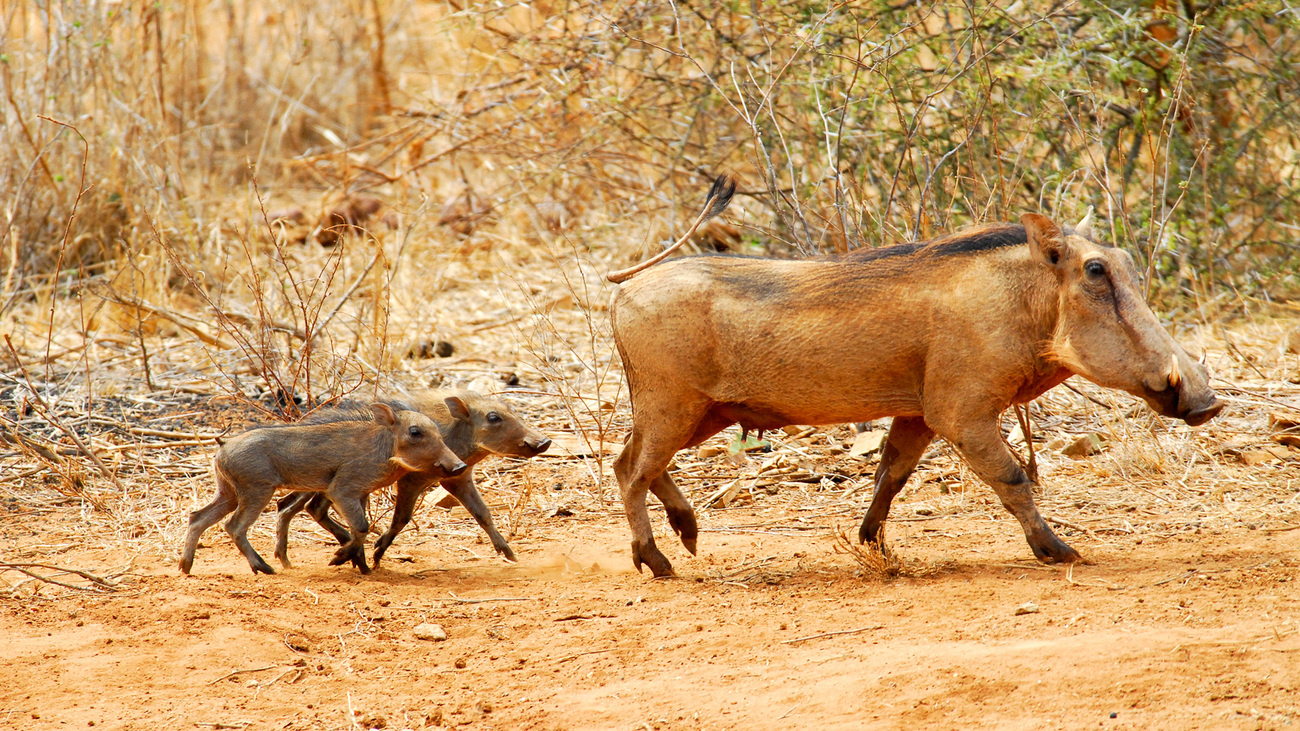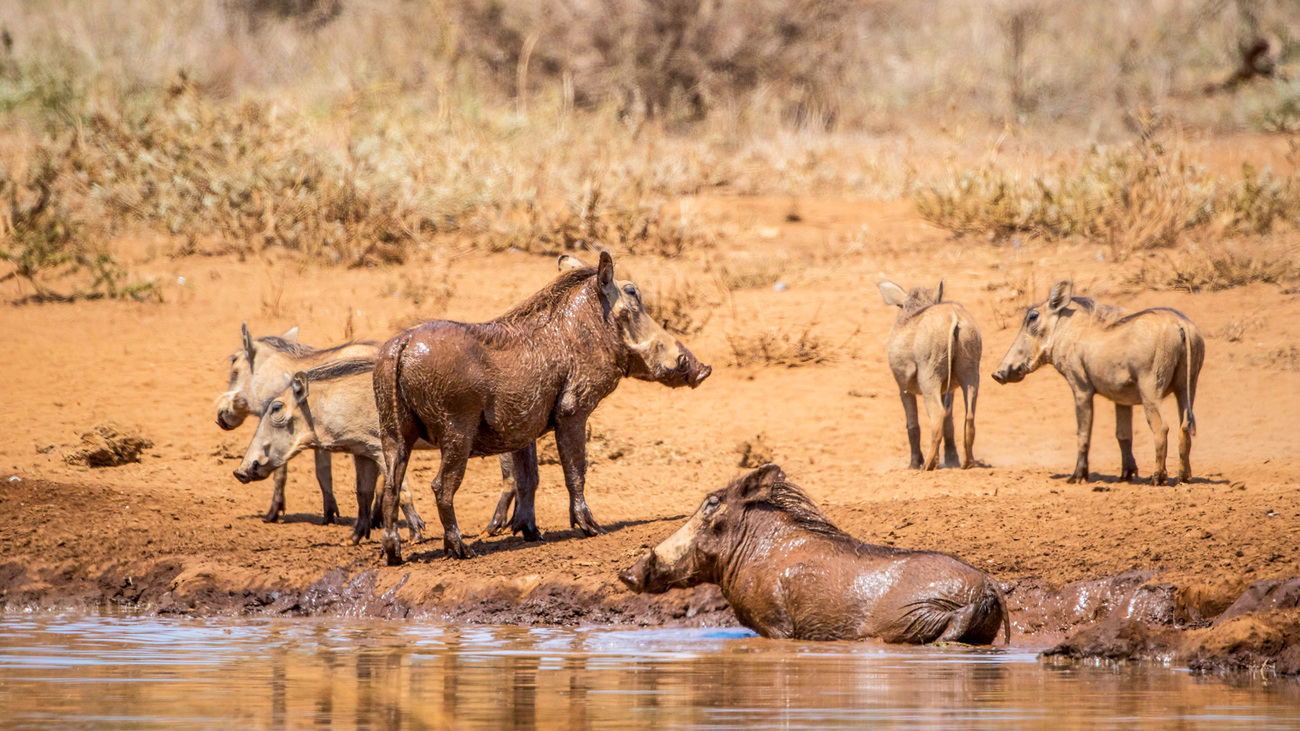Warthogs
What are warthogs?
Warthogs are sparsely-haired wild pigs found across sub-Saharan Africa. These unique animals have large heads and bodies with short legs, coarse manes down their backs, and long, thin tails they hold upright when running. Their most distinctive features are the large bumps on their faces that look like warts—hence their name.
These fleshy growths help protect warthogs, shielding their eyes and faces when they’re fighting, which occurs between males during mating season. These warts are also covered in short hairs that help them feel vibrations in the ground so they can sense nearby threats while grazing. Warthogs are also well-known for their two sets of tusks—a pair of long, protruding lower tusks that measure around 15 centimeters (six inches) each and are used when fighting, and a pair of upper tusks that form a 60-centimeter (two-foot) long semicircle.
There are two warthog species, the widespread common warthog and the desert warthog. Common warthogs have larger tusks and more extensive manes than their desert cousins, and are commonly found across sub-Saharan Africa in open plains, grassland savannahs, and woodlands. Desert warthogs, on the other hand, have longer legs and less body fat, which makes them well adapted to the drier conditions of semi-arid regions of Somalia, Ethiopia, and Kenya.
Both species eat a predominantly herbivorous diet of roots, bulbs, bark, grasses, berries, and other plants, using their snouts to dig through the soil to find food and kneeling on their padded knees to eat short grass. They also eat worms, insects, and carrion. While largely solitary animals, a female warthog sometimes lives in communal groups—known as ‘sounders’—with other females and their piglets. However, she chases off her current litter before birthing the next after a gestation of around six months. Males and females only come together to mate.
Warthogs play important roles in the ecosystems of African savannahs and grasslands. As grazers, they aerate the soil with their snouts while scavenging for food, which supports plant growth. Their abandoned burrows provide homes for other wildlife, while the parasites that live on their skin provide food for birds. Warthogs are also key prey for lions, leopards, hyenas, and wild dogs, helping support these predator populations.
While not currently endangered, warthog numbers are declining across Africa due to poaching, droughts, and habitat loss. Preserving these unique animals is a priority for maintaining healthy ecosystems.
What is a warthog’s scientific name?
The scientific name for a warthog is Phacochoerus which comes from the Greek phakos, meaning ‘wart’, and khoiros, meaning ‘pig’ or ‘hog’.
Each species of warthog has its own unique scientific name too. The common warthog is known as Phacochoerus africanus, while the desert warthog is known as Phacochoerus aethiopicus. Both names are reflective of their lineage, with africanus and aethiopicus referencing where each species is found. Both types of warthog belong to the pig family Suidae.
Are warthogs endangered?
Both warthog species are currently listed as least concern on the IUCN Red List. However, populations of the common and desert warthogs are estimated to be declining across Africa due to poaching and habitat degradation.
Where do warthogs live?
The common warthog inhabits open plains, grassland savannahs, and woodlands across sub-Saharan Africa. They are found in most countries from the Sahara Desert as far south as South Africa. Desert warthogs occupy the semi-arid regions of Somalia, Ethiopia, and Kenya in East Africa.
Warthogs make their homes in abandoned aardvark burrows, called ‘aardvark hotels’ by locals. Females live in communal groups—called ‘sounders’—of up to 40 individuals. These sounders share burrow complexes and huddle together for warmth at night. Adult males, on the other hand, are mostly solitary with distinct territories, though they allow young males to live alongside them.
Threats
While not currently endangered, warthog populations face mounting threats across Africa, including poaching, retaliatory killings, habitat loss, and climate change.

Poaching
Poachers illegally hunt warthogs across Africa for their ivory tusks which, unlike elephant tusks, are not illegal to sell, and for their bushmeat, which is sold locally. Warthogs are also hunted for sport or to be used as bait to attract and kill larger warthog predators, like lions and leopards. Conservation efforts are helping to reduce poaching.
Habitat degradation, loss, and fragmentation
Increasingly, human activities—such as agricultural practices, farming, and livestock rearing—have expanded into warthogs’ natural habitat and reduced the size of their range.
Because of this, warthogs increasingly struggle to find food, particularly in the dry season, and are prone to raiding crops and farmland instead. This then incites human-wildlife conflict.
Retaliatory killings
Due to habitat loss and the expansion of agriculture, warthogs are increasingly coming into close contact with humans, as they’re forced to leave their habitats in search of land and food. When entering these human settlements, they often raid crops and scavenge through pastures, where they can spread swine fever and foot-and-mouth disease to livestock. To prevent this, farmers shoot, snare, or poison warthogs.
Some districts have even implemented warthog eradication programs in an effort to protect their livelihoods.
Climate change
Because of climate change, warthogs’ habitat is becoming increasingly prone to droughts. Though they can survive several months without water, these pigs do still rely on it for drinking and cooling down. Increasingly long periods of drought put their survival at risk.
FAQs
What do warthogs eat?
Warthogs have a varied, mostly herbivorous diet. Using their tusks and snouts, they dig in the soil for roots, bulbs, bark, grasses, berries, and other plants. Warthogs also opportunistically consume small animals like worms, insects, and carrion.
Interestingly, a warthog’s diet changes seasonally. In wet periods, they consume more green vegetation and insects, while they eat bulbs and tubers during dry seasons when plant life is more scarce.
What sound does a warthog make?
Warthogs have an extensive vocal repertoire they use to communicate, from rhythmic courtship chants that sound like a starting car engine to high-pitched squeals.
Sows stay in contact with each other and their piglets using chirps, grunts, snorts, and growls, while boars use threatening roars to scare off intruders and softer tusk clacking to convey submission. Warthogs’ wide-ranging vocal abilities likely developed to enable communication in dense habitats with limited visibility.
Do warthogs have tusks?
Both male and female warthogs have two sets of tusks. The lower tusks are over 15 centimeters (six inches) long and protrude outwards to act as weapons, while the upper tusks form a semicircle and measure as much as 60 centimeters (two feet).
Unfortunately, these ivory tusks, which are used in digging for food, fighting rivals, displays of courtship, make warthogs a popular poaching target.

Are warthogs pigs?
Yes. Warthogs are a member of the pig family Suidae of the order Artiodactyla. They share a similar facial structure and body shape with both domestic and wild pigs.
Can warthogs swim?
Though warthogs enjoy cooling down in mud wallows and submerging themselves in waterholes to regulate their temperature and avoid heat stroke, they don’t actually swim. However, they will paddle across slow-moving rivers or dams.

Do warthogs have warts?
Technically, no. The bumps on a warthog’s face may look like warts, but they’re actually protective bumps made up of fat deposits. These thick, fleshy growths help to shield a warthog’s eyes and face when fighting. These warts are also covered in short hairs that help them feel vibrations in the ground so they can sense nearby threats while grazing.
While males have two pairs of warts, sows have only one. The size and length of these warts often correlate with a male’s status and maturity, showcasing his virility and fighting skills.
Do warthogs live underground?
Yes, warthogs shelter in burrows underground. However, they don’t create the tunnel networks themselves. Instead, they claim abandoned aardvark dens as their own, using their rumps to widen the entrance and allow their stocky bodies to fit through. They then sit that way, with their tusks protruding outwards to guard the entrance.
How big are warthogs?
Identifiable by their large heads, warthogs typically stand around 76 centimeters (30 inches) tall at the shoulders, measure 105 to 150 centimeters (41 to 59 inches) long from head to hind, and have tails of around 50 centimeters (19 inches). Females weigh 50 to 75 kilograms (110 to 165 pounds), while males can weigh as much as 150 kilograms (330 pounds).
How fast can a warthog run?
Warthogs can run at a top speed of around 50 kilometers per hour (31 miles per hour), a pace at which they can sprint for short distances to escape predators.
How long do warthogs live?
Warthogs can live for up to 15 years in the wild.
Our work
IFAW’s work in Africa supports numerous species, including warthogs.
In partnership with Community Markets for Conservation (COMACO), we launched a project to support small-scale, low-income farmers in the Chikomeni and Mwase Mphangwe chiefdoms, tucked between Zambia’s Lukusuzi and Malawi’s Kasungu National Park. Launched in 2021, our efforts have helped to re-train poachers (who would otherwise target warthogs for their tusks and bushmeat) to become farmers, enabling them to give up these illegal practices.
IFAW also supports the Panda Masuie Release Project, an initiative that aims to reintroduce and release rescued orphaned or injured elephants into Zimbabwe’s Panda Masuie Forest Reserve. While this project is proving to be a huge success for elephant populations, which have increased by 79% in the last year, it has simultaneously benefited warthogs, who have more than doubled in numbers. This is because elephants are ecosystem engineers that help maintain healthy habitats where warthogs can thrive.
How can you help?
Warthog populations across Africa face growing threats from poaching, habitat destruction, and climate change. Support conservation efforts to create a better future for these animals.
